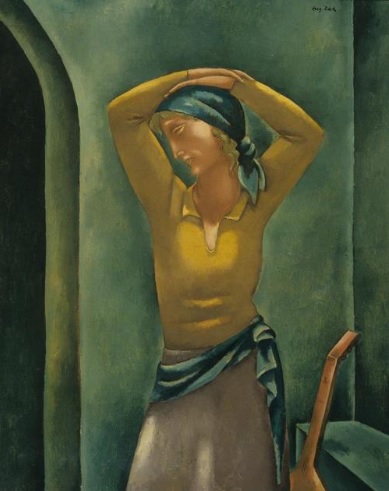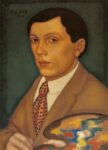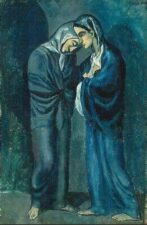
Eugène Zak
Polish, 1884-1926 (active France)
Woman with a Mandolin, 1924 ca.
oil on canvas
39 1/4 × 31 1/4 in.
SBMA, Gift of Spencer Kellogg, Jr.
1943.5.4

Self Portrait, 1911 National Museum, Warsaw
RESEARCH PAPER
Eugène Zak’s 1924 oil on canvas, “Woman with a Mandolin” is a representational painting of a woman dressed in plain, yellow, clothing standing with arms raised and elbows bent above her tilted head. Her hands overlap, resting gently, on the crown of her head which is covered with a teal blue scarf. Wisps of blond, curly hair frame her face. A matching colored teal blue sash sits diagonally around her waist and hips. With a somber look the woman stands out from the monochromatic blue background. A portion of the wooden mandolin is visible on the lower right.
The eye captures the prominent vertical lines in the elongated, standing figure posed front and center of the painting. There is symmetrical balance with arms raised and elbows bent, forming triangles on each side of the woman’s head. Light is reflected on her face in profile, emphasizing her left cheek, upper torso and right leg which is in contrapposto position. The facial features “recall the profiles of ancient Greek art, with the nose angled straight from the forehead and distinctly outlined eyes” (Wikipedia 2022), while the face bears a melancholic, nostalgic expression. “The angularity of the woman’s features with its exaggeratedly ‘Greek’ profile became a characteristic type in the artist’s later work” (Curatorial label).
This artwork, “Woman with a Mandolin” is the artist’s response to the Blue Period of Picasso, “with its emphasis on marginalized figures, often shown in melancholic states of reverie” (Curatorial label). “Both in content and form, the paintings of Picasso’s Blue Period convey a deep sense of loss and mourning. In terms of technique, they are monochromatic with austere lines and efficient composition” (Artsper 2022). One such example is that of Picasso’s “Two Sisters (The Meeting)” in which Picasso portrays the meeting of a prostitute from the prison hospital with her sister, a nun. “ ‘Art flows from pain and sadness’ was Picasso’s approach… . He refracts through the prism of unhappiness and sorrow his observations of his friends, of the blind and poor, or sad mothers and prostitutes” (Hermitage Museum).
One can easily make the comparison in content and form between “Woman with a Mandolin” and Picasso’s “Two Sisters (The Meeting)”. Both paintings feature women whose figures appear forlorn. Both artists employ monochromatic harmonies composed of variations on the same hue of blue with differences of value and intensity. “Zak’s paintings followed the style of Miserablism common at that time in the European culture. Then, the mood of melancholy or a gentle lyricism identified with alienation, or even fear of life was very characteristic. It was supposed to express the attitude of escapism; the escape from the present into the world of art represented by the lyrical violinists, mandolin players, or dancers” (Kossowska 2002).
Eugène Zak was born to a Jewish family in Mogilno (Belarus) on December 15, 1884. His father was originally from Poland and died in 1892. His mother then settled in Warsaw with Zak where he studied in the Polish capitol and encouraged by his mother, started to paint. In 1901 at age sixteen, Zak decided to move to France. There he began his formal artistic education at the Parisian École des Beaux-Arts under the guidance of J. L. Géröme. Zak made his debut at the Salon d’Automne, Paris in 1904. He also exhibited his artwork at the Salon des Indépendants and Société National des Beaux-Arts. His solo exhibition in 1911 at the Galerie Druet brought him to public and critical acclaim.
“From the beginning, Zak expressed his artistic temperament through a sophisticated application of line… In the early stage of his career, he approached the style of the Nabis through the manipulation of flat areas, enclosed within distinct contours and faded, slightly matte colors. Even before World War I, some of his compositions were in line with the idyllic tradition represented by works of such artists as Nicolas Poussin, Claude Lorrain (called le Lorraine). Antoine Watteau, and most of all Puvis de Chavannes, whose ‘Poor Fisherman’ at the Louvre inspired a number of Zak’s paintings and drawings” (Wikipedia 2022).
“Zak became one of the leading lights of the Rytm (Rhythm) Group. He painted canvases in which planes, volumes, contours and masses interact, in which one and the same curve links figures and landscapes. His endless color combinations are intended to stimulate feelings of well-being or malaise. His surfaces are ordered with delicacy and subtlety and are designed to inspire emotion in the same way as a poet or musician” (Oxford Art Online 2011).
“Zak’s work created between 1924 -1926 take on a universal and archetypal dimension obtained through the abstract space into which the depicted figures immerse. At this point of his artistic career, the question of the sense of human existence becomes a major theme in the artist’s works. Typically, for Zak’s later paintings, forms are accentuated in these works by a subtly-molded, softly-contoured area of color, while shapes are enhanced by harsh highlights. At the time, the artist began to explore new solutions in terms of color scheme, decidedly placing color above drawing. The lightened chromatic palette took on refined nuances as it was enhanced by a delicate tone grading. The prominent features of Zak’s paintings were irregular paintbrush and impasto strokes which used to create diverse texture effects” (Kossowska 2002).
Prepared for the Santa Barbara Museum of Art Docent Council by Josephine Carrillo, January 2023
Bibliography
Artsper Magazine. “Picasso’s Blue Period: A Color Full of Significance” January 27, 2022
http://www.blog.artsper.com Jan. 12, 2023
Kossowska,Irena. “Eugeniusz (Eugene) Zak” Art Institute of the Polish Academy of Science, March 2002.
http://www.culture.pl Jan. 13, 2023
Oxford Art Online. “Zak, Eugeniusz or Eugène”. Benezit Dictionary of Artists. Oxford University Press, New York, 2007. Published online: 31 October 2011
http://www.oxfordartonline.com (a by subscription only data base available at UCSB)
The State Hermitage Museum. Picasso, Pablo. “Two Sisters (The Meeting)”. 1902.
http://www.hermitagemuseum.org Jan. 15, 2023
Wikipedia: The Free Encyclopedia. “Eugeniusz Zak”. Last edited 20 December 2022.
http://www.en.wikipedia.org Jan. 20, 2023

Picasso - The Visit [The two sisters] (L'entrevue [Les deux soeurs]), 1902
SBMA CURATORIAL LABELS
Zak was a well-regarded participant in the Parisian avant-garde, who was nimble enough to assimilate many competing threads – from the group of artists known as the Nabis, to Puvis de Chavannes, to Picasso and the School of Paris – to create a stylized figural approach uniquely his own. This painting is his reply to the Blue Period of Picasso, with its emphasis on marginalized figures, often shown in melancholic states of reverie. The angularity of the woman’s features with its exaggeratedly ‘Greek’ profile became a characteristic type in the artist’s later work.
Zak’s inroads in Paris made him an influential leader of progressive art in his home country of Poland. Sadly, his premature death at the age of 41 from a heart attack brought his flourishing career to an abrupt end.
- Ridley-Tree Reinstallation, 2022
